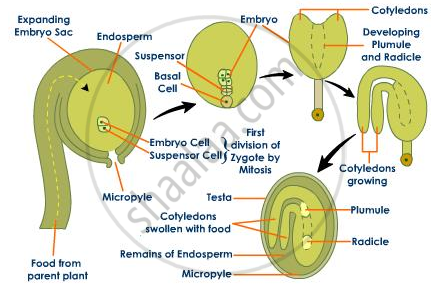Advertisements
Advertisements
प्रश्न
Read the statement and answer the questions that follow.
A flower of brinjal has 520 ovules in its ovary. However, it produces a fruit with only 480 viable seeds.
(a) What could have prevented the rest of the 40 ovules from maturing into viable seeds? Explain giving a reason.
(b) Describe the development of a dicot embryo in a viable seed.
(c) Why certain angiospermic seed albuminous while others are exalbuminous? Explain.
उत्तर
Ovules develop into viable seeds which are capable of germination under suitable environmental conditions. Viability is influenced by various conditions like humidity, temperature and availibility of oxygen. Viability can be lost due to:
(ii) damage to embryo
(iii) denaturation of enzymes
(iv) extremly high temperatures
(v) excessive dry or damp weather
Zygote is the first cell of early embryo development in flowering plants including bean plant.
The zygote develops after the fusion of male sperm nuclei released from pollen grain with the egg present in the embryosac. This fusion is called syngamy.
The embryo develops at the micropylar end of the embryo sac where the zygote is situated. The zygote divides into a larger cell called suspensor cell towards micropylar end and a smaller cell called embryonal cell towards antipodal cells.
The suspensor cell divides mitotically to form 6-10 celled structure called suspensor. The last suspensor cell is called hypophysis that forms radicle tip. The zygote divides mitotically and gives rise first to the pro-embryo, then to the globular and heart-shaped mature embryo. A typical dicot embryo consists of an embryonal axis and two cotyledons. The portion of the embryonal axis above the level of cotyledons is called epicotyl. It contains the plumule (shoot tip). The portion below the axis is called hypocotyl. It contains the radicle (root tip). The root tip is covered by the root cap.

APPEARS IN
संबंधित प्रश्न
List the three states the annuals and biennial angiosperms have to pass through during their life cycle.
A capsicum flower has 240 ovules in its ovary. But, it produces a fruit with only 180 viable seeds.
Give an example of an angiosperm seed that has a perisperm. Name the part the perisperm develops from.
Name a plant which flowers every twelve years.
Name the terminal stage of ageing in the life cycle of plants
Give a reason for the Following:
Pollen grains of wind-pollinated flowers are produced in large quantities.
Explain the events upto double fertilisation after the pollen tube enters one of the synergids in an ovule of an angiosperm.
A typical flower has ______ different kinds of whorl.
Science of cultivation, breeding, marketing and arrangement of flowers is called ______.
Angiosperms have dominated the land flora primarily because of their ______.
